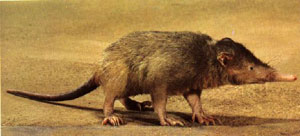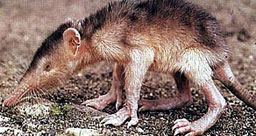An animal unique to the Dominican Republic
The paradoxical almiquí (Solenodon paradoxus), also known as or solenodonte Agout is a placental mammal from the family solenodonte. It can only be found on theisla de la Española, which is shared by Haiti and the Dominican Republic.
Description
The Solenodon paradoxus is very similar to a shrew. It usually weighs between 0.6 and 1.0 kg, and has a height between 28 and 33 cm (the tail adds another 25 cm). It has reddish-brown fur on most of the body, which is lighter colored on the bottom.
The tail, legs, muzzle and ear tips are devoid of hair. The forelegs are noticeably more developed than the rear, but all have claws capable of digging.
Genus
There used to exist, until times of colonization, the species S.marcanoi, but it is now extinct. On the island of Cuba is another species of the genus, S.cubanus (subgenus Atopogale), known as the Cuban almiquí. Currently, some biologists consider “Atopogale” as an independent genre. All species belong to the order Insectivora solenodonte and family Solenodontidae.
Reproduction
Both sexes are similar. Males have a penis and testicles that lie hidden within the abdominal cavity. The female has an irregular estrous period that apparently is not related to the seasons. She can have two litters a year, of 1-3 young.
Normally, only 2 offspring survive, since the female only has two breasts. They weigh 40 to 55 grams at birth. The young are nursed for about 75 days, although the young often stay with parents and the other litters, with as many as 8 animals coexisting in the same burrow.
Defense mechanism
Besides having a poisonous bite, solenodon has glands in the armpits and groin, which exude an odor resembling that of goats. Apparently it is not immune to his own poison as some have been witnessed to die after having fought and received minor injuries.
Feeding
The solenodonte eat a wide variety of plant and animal matter, such as arthropods, worms, gastropods, and small reptiles. They also eat roots, fruits and foliage (however, some animals that have been studied have declined plant food). They explore the earth with their long nose, dig with their strong claws or destroy rotting logs. The solendontes in captivity have been observed swimming regularly and only drink water during these times. Perhaps the long snout makes drinking difficult in other conditions.



Endemic species of La Hispaniola
Habitat and life
One reason why the solenodon was unknown to science for so long is because of its nocturnal habits. Furthermore, there are many, which have not been assigned a role as a member of the food chain in any ecosystem. The Solenodon habitat is usually in wooded areas or rocky thickets, often near agricultural land, where they can dig elaborate underground tunnels.
An endangered animal
The Solenodon paradoxus was not known to science until Brandt described them in 1833. The decrease in suitable environments, in addition to the predation by introduced animals, have contributed to the endangerment of this rare species, whose populations have declined dramatically in recent decades. In fact, they were thought to be extinct until specimens were found inside the island in1907.
During the early twentieth century, they were not considered to be threatened. In 1981, after exhaustive search, it was concluded that the solenodonte in Haiti was functionally extinct, surviving only in the remote mountains of the south.
In 1987 they could still be found in both countries, although with a severely threatened status in Haiti. Reports in 1996 claimed they could still be found on both sides of the border, in protected areas like Haitises National Park.

